R-13 Risk Bulletin – March 2021
Monthly Risk-Bulletin: March 2021**
Last revised: April 14, 2021
Objective
The objective of the Monthly Risk-Bulletin is to provide an overview a) of lessons learned during the past month in the project, b) of a score-card-type system to communicate the state of risk of supply chains impacted by COVID-19 supporting health infrastructure and the workforce between the U.S. and Mexico, and c) of a communication system to facilitate the restoration of broken supply chains and the formation of new ones to reactivate trade between U.S. and Mexico. The report aims to offer valuable insights to the general public and decision-makers towards informed preventive actions to reduce the current pandemic’s potential impact on critical supply chains and better strategize about feasible social, economic, and environmental risk-mitigating actions against COVID19 and converging threats. This bulletin is jointly produced by the project’s PIs, the project’s contractors, and the U.S. binational task force serving as advisors to the project.
| Project PIs | |
|---|---|
| Zenon Medina-Cetina, PhD – PI | Gregory Pompelli, PhD – Co-PI |
| Matt Cochran, DVM, MIA – Co-PI | Maria Jose Perez-Patron, PhD – Co-PI |
| Miriam Olivares, GISP – Co-PI |
| Document prepared with the support of: | Reviewed & Approved by: |
| Enrique Z. Losoya, Guillermo Duran, Juan Pablo Alvarado, Barnett Jimmy | Dr. Medina-Cetina – PI |
| PhD Students SGL – Research Assistants | Date: 05/14/2021 |
Suggested citation:
Medina Cetina, Z., Pompelli, Gregory., Cochran, Matt., Olivares, Miriam., Perez-Patron, Maria J., Duran, Guillermo., Alvarado, Juan Pablo., Z-Losoya, Enrique., & Lopez-Acosta, Araceli. (2021). CBTS-SGL Monthly Risk Bulletin: March. https://r13-cbts-sgl.engr.tamu.edu/
@misc{Medina2021,
author = {Medina Cetina, Z. and Pompelli, Gregory and Cochran, Matt and Olivates, Miriam, Perez-Patron, Maria J. and Duran, Guillermo and Alvarado, Juan Pablo and Alexi, Allen, and Torres, Cesar, and Barnett, Jimmy, and Lopez-Acosta, Araceli, and Sanchez-Siordia, Oscar, and Rojas, Minerva and Zarate-Losoya, Enrique},
title = {*CBTS-SGL Monthly Risk Bulletin: March.*},
url={https://r13-cbts-sgl.engr.tamu.edu/},
year={2021},
month={March}
}Table of Contents
R-13 Risk Bulletin – March 2021
- Objective
- Introduction
- 1. Project Status & Lessons Learned
- II. Risk Communication Mechanism
- II. Restoration and Creation of Supply Chains
- References
Introduction
I. Project Status & Lessons Learned
Contributing Milestone 2: Taskforce
- The eighth Taskforce meeting is scheduled for 03.26.21
- There are four additions to the U.S.-Mexico COVID-19 Taskforce:
- Thomas Wilkinson, MD, Chief Medical Information Officer, Office of the Chief Medical Officer (OCMO), CWMD-DHS
- Dr. Julia Marinessen, Health Attaché, U.S. Department of Health and Human Services (HHS), U.S. Embassy in Mexico City
- Dr. Julie Loisel, Associate Professor, Department of Geography, Texas A&M University
- Dr. Dennis Gorman, Interim Department Head, Department of Epidemiology and Biostatistics, Texas A&M University
Milestone 3: Data-Lake
- Definition of preliminary objectives and hypotheses following the scientific method was completed for the Research Problem 2: Personal Protective Equipment research problem & Research Problem 3: Auto Manufacturing Sector.
- A Risk Matrix version 3.0 was produced for data classification in terms of evidence, geographic location, Risk components, type of variable, and for metadata records to archive and curate information (see Fig. 1).

Milestone 4: Risk-Bulletin
Research Problem 2: Personal Protective Equipment
Objectives
- To identify and characterize the main entities (from vendor to customer) involved in PPE supply chain for U.S. and Mexico.
- To describe the main causes of PPE shortage in both U.S. and Mexico.
- To study how PPE shortage in healthcare service facilities has contributed to COVID-19 Spread between medical and non-medical staff in U.S., and especially in Mexico.
- To investigate what are the PPE quality standards for medical staff in both U.S. and Mexico, and if the standards have been enforced.
- To analyze how PPE shortage has contributed to social instability in Mexican healthcare institutions (and U.S. institutions if applicable), and to a lack of medical volunteers.
Research Problem 2: Auto Manufacturing Level
- Definition of preliminary objectives following the scientific method was completed for Auto Manufacturing Sector research problem:
- Objectives:
- To identify and characterize the main companies involved in auto manufacturing sector for U.S. and Mexico.
- To investigate how U.S. and Mexico auto manufacturing sector has been impacted due to COVID-19 through social, economic, and environmental metrics.
- To determine if the auto manufacturing sector companies are willing to encourage vaccination on their workers.
- To study how manufacturing workplaces have adapted to ensure a safe environment against COVID-19.
- Objectives:
The flowchart shown in Fig. 2 shows the steps planned to generating a Minimum Viable Models for the five research problems: Vaccination, PPE, Healthcare, Auto Manufacturing, and Corn and Fruits.
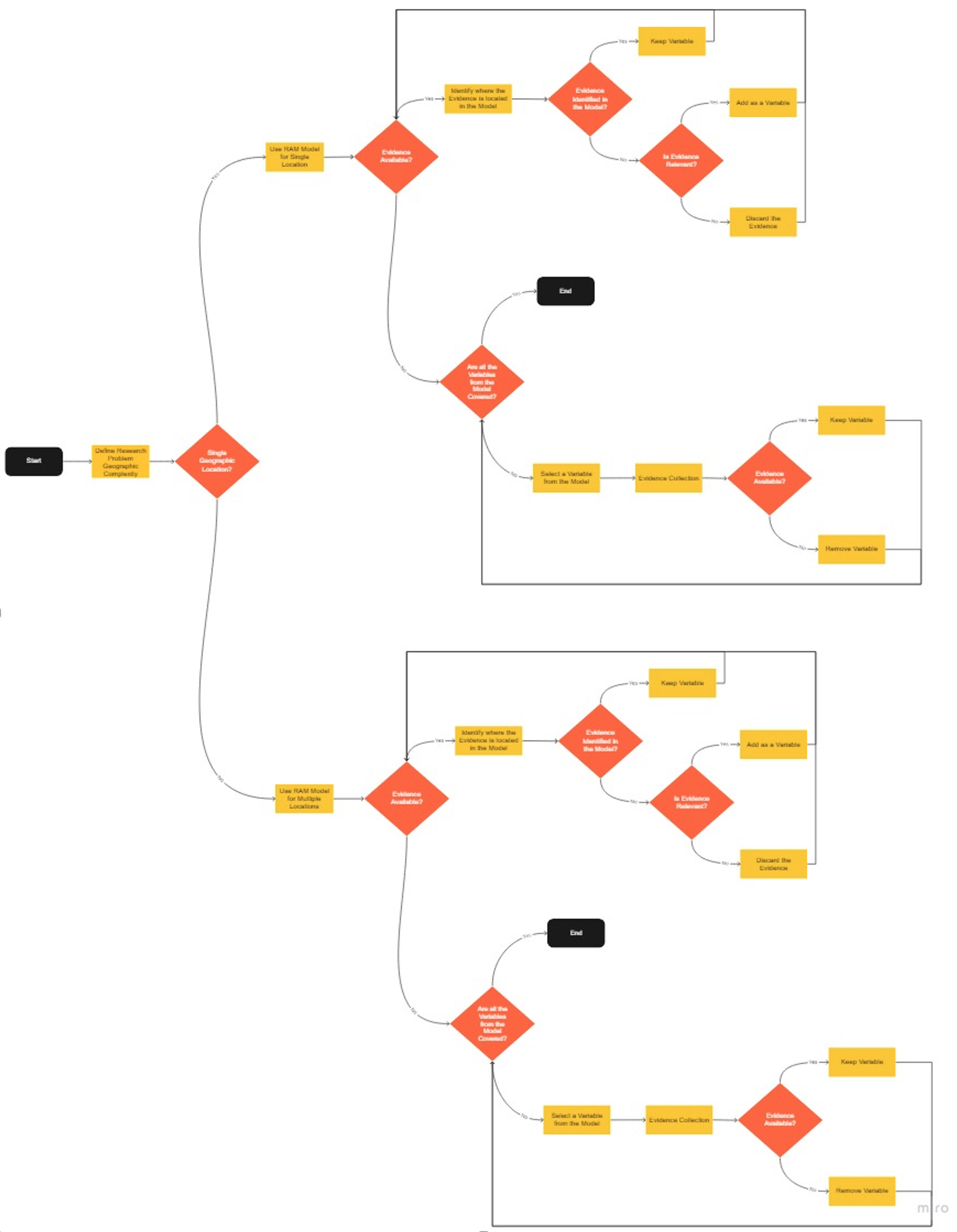
Excess Mortality in Mexico
Palacio-Mejía et al. (Mejı́a et al., 2021) journal paper about Excess Mortality in Mexico main results are shown below:
- It is probable that the number of COVID-19 deaths reported by the National Health Institution or “Secretaría de Salud” is anunderestimate of the total deaths due to the virus. From Observed Weekly Deaths are the number of deceases records from the National Database of Civil Records (SEGOB, 2021) and Mexico’s Health Department (Salud, 2020). Expected Weekly Deaths from mortality statistics between 2015-2019 provided by Mexico’s National Institute of Statistics and Geography (INEGI) (Program, 2021)
- Between December 29th, 2019 and January 3rd, 2021 estimated excess deaths were 326,610 (45.1%) as shown in Fig. 3.
-
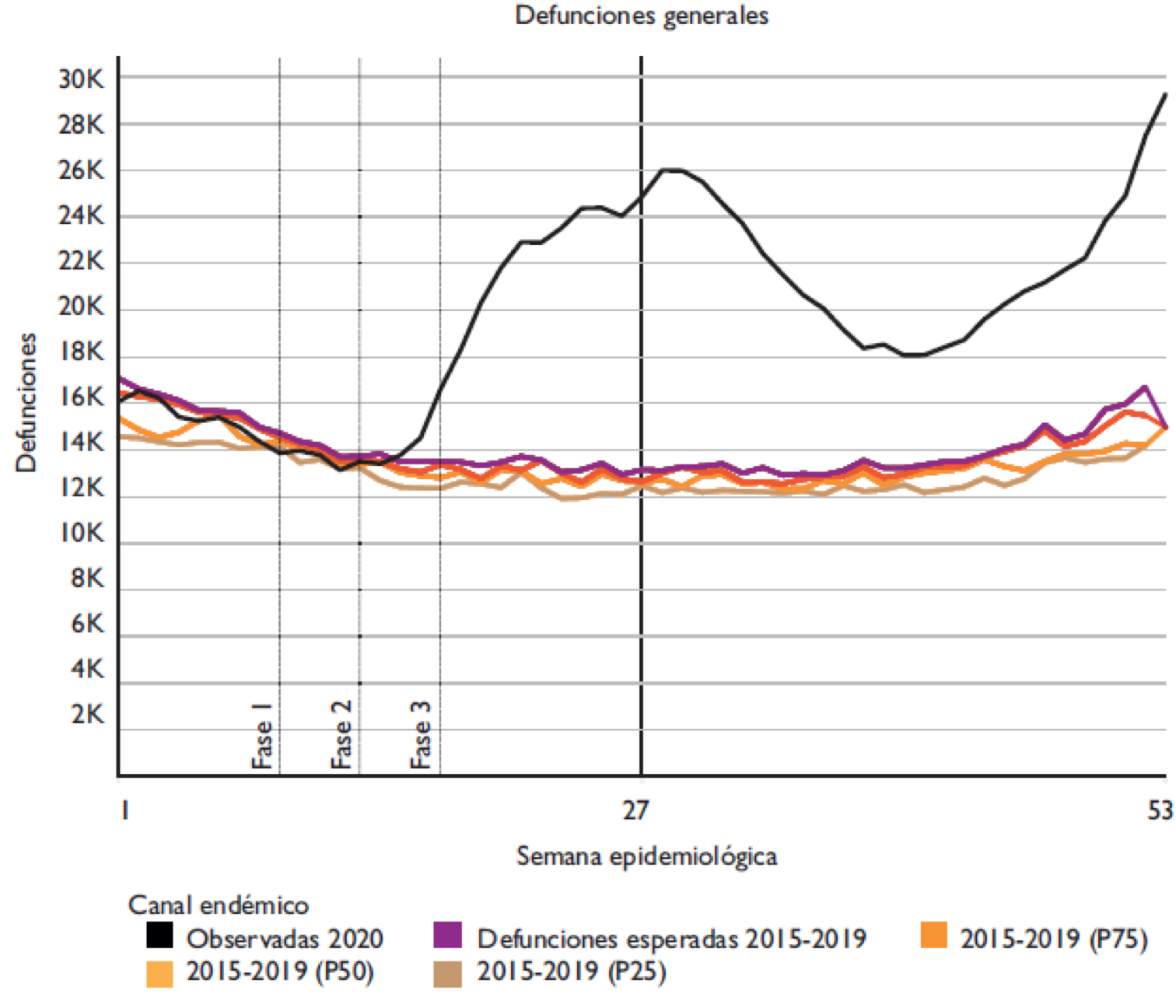
- The group of people with ages between 45-64 were the most impacted with an excess death of 71.5% as shown in Fig. 4
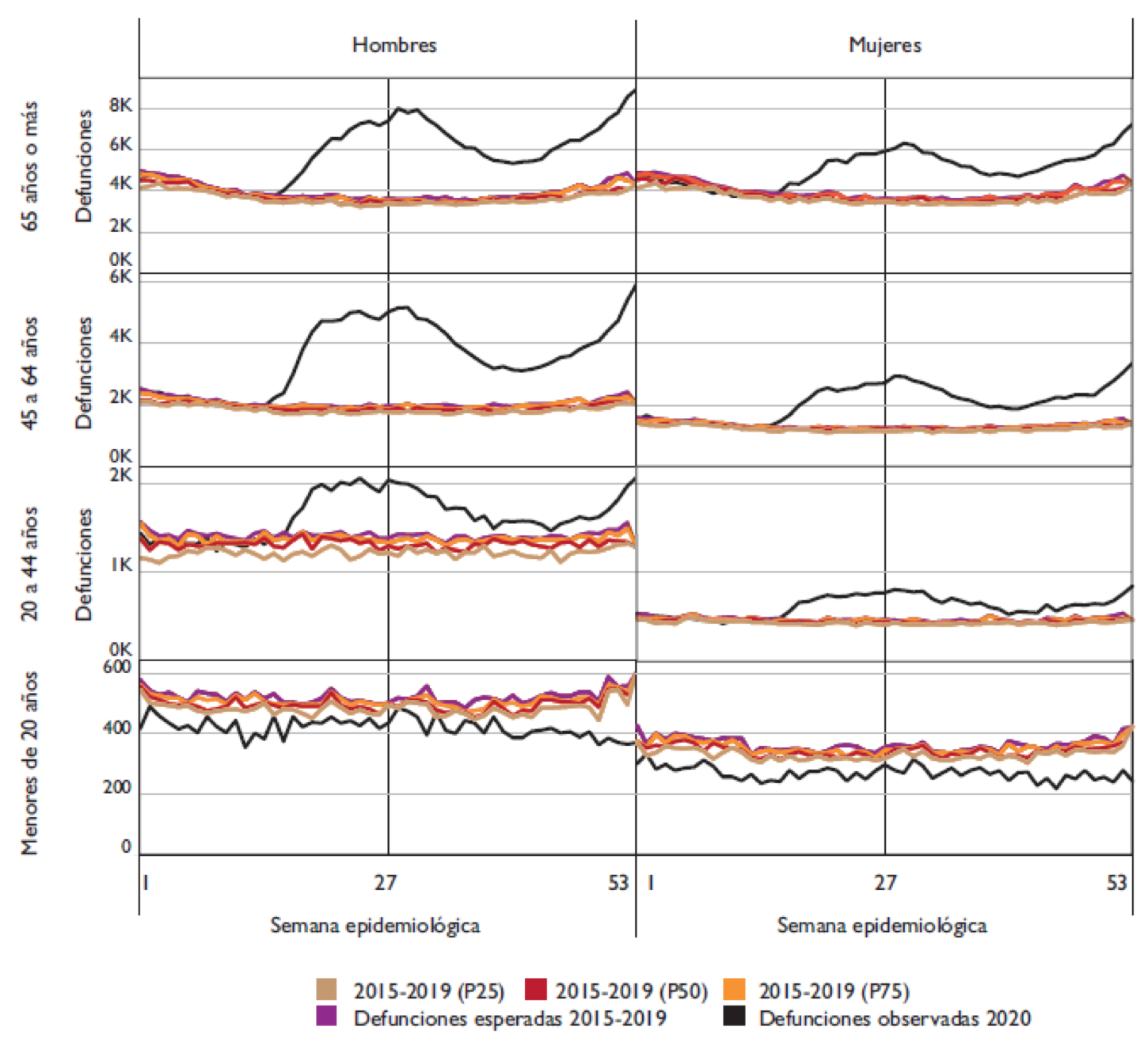
- 52.1% of the excess deaths is concentrated in 5 federal entities, see [Fig. 5} for a breakdown of excess deaths percentage by state.
- Ciudad de Mexico: 57,141 (74.4%).
- Estado de Mexico: 54,262 (69%).
- Puebla: 26,499 (68.8%).
- Veracruz: 17,257 (31.9%).
- Guanajuato: 15,620 (42.5%).
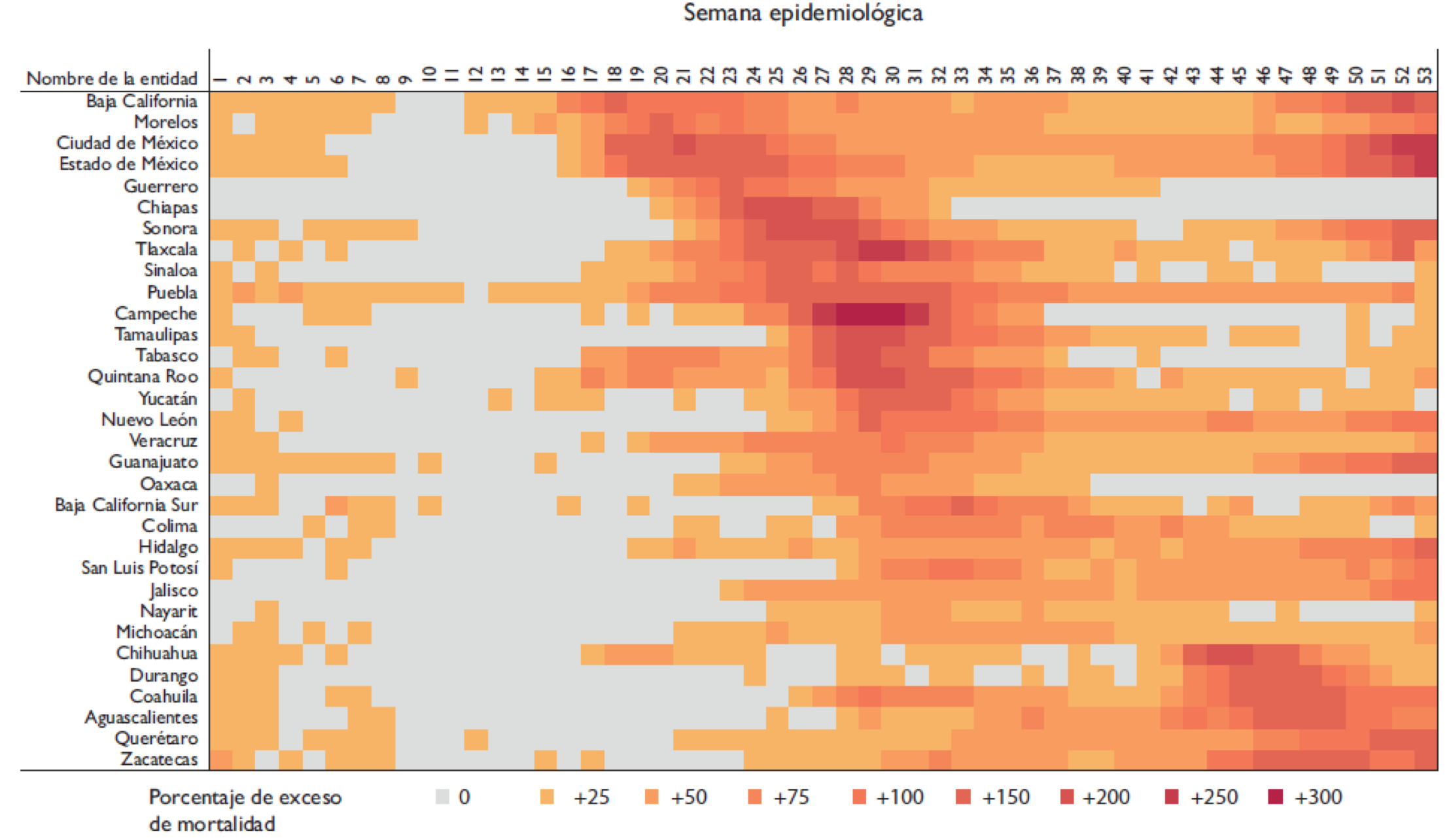
- Mexico is number 3 in excess deaths (45.1%) after Peru (66.7%) and Ecuador (61.8%).
II. Risk Communication Mechanism
R-13 Dashboard Development
The first version of the R-13 dashboard has been reviewed by the SGL (Stochastic Geomechanics Lab) team.
A second version of the R-13 dashboard is currently under development, and the key feature in this version is that all the information from version one plus additional information such as atmospheric and anthropogenic data will be presented in terms of threats, systems, exposures, Risk metrics, and mitigating actions that are required information to perform Risk Assessment and Management.
As previously mentioned, the risk matrix is used to properly classify information in terms of the five previously mentioned Risk Assessment and Management components (see Fig. 6).
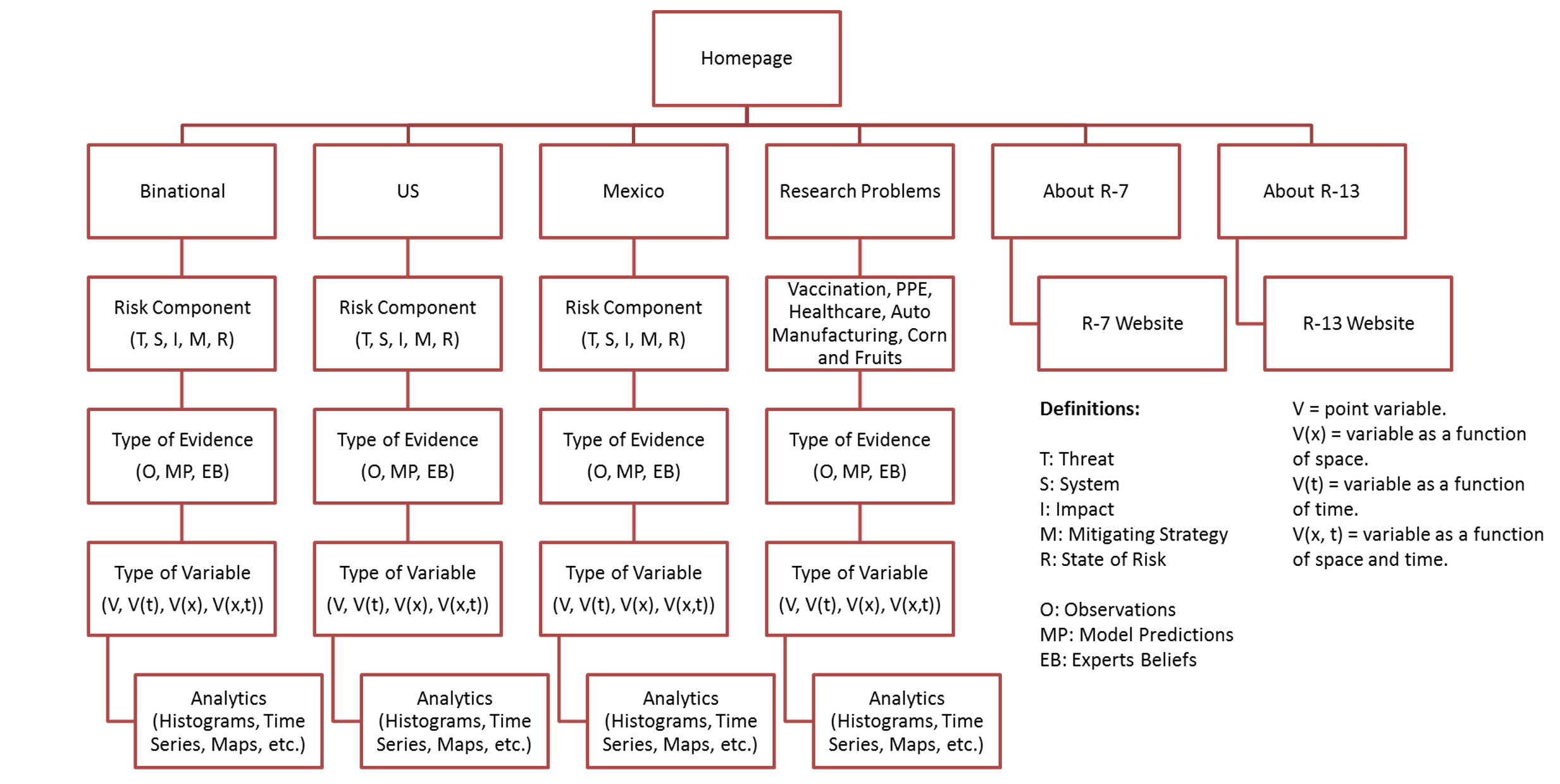
A Hierarchical Model (see Fig. 6) was produced to illustrate the structure of CBTS-SGL Website for Phase 2. It is important to notice that no exposure information was identified from the version one of the dashboards. In the case of Mexico dashboard, it is reporting almost all the variables from the official COVID-19 Mexico dashboard excluding estimates of COVID-19 confirmed cases, deaths, and active cases. Therefore, no exposure information is available at official Mexico dashboard as well.
Continuing working on defining the methodology to integrate risk model and supply chains sources of information into an index.
- Reviewed spanish translations of risk bulletins for November, December, January, and February
- Identified vulnerability indexes and sources of data for the scorecard literature review
- CDC’s Social Vulnerability Index (SVI) (Flanagan et al., 2018)
- CENSUS Community Resilience Estimates (CRE) (DeSalvo, 2020)
- Surgo Ventures’ COVID-19 Community Vulnerability Index (CCVI) (Amram et al., 2020)
- NYT’s COVID-19 Risk Index
- Identified two preprocessed aggregated databases related to COVID-19
- COVID Act Now – Non-profit providing free API for non-commercial use (COVIDActNow, 2021)
- Downloaded and briefly assessed data from the White House Daily Community Profile Report
- Merged both databases and generated visual maps at a county level for the CDC SVI, Surgos’ CCVI, and estimated infection reproduction factor (Ro) as visualization examples
Restoration and Creation of Supply Chains
No progress was reported on this section of the project.
References

